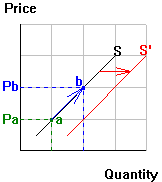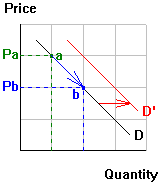(i) given any P, distance out S tells us Qs
(ii) given any Q, distance up to S tells us the unit's supply price (Ps), which equals its marginal cost.
(i) given any P, distance out D tells us Qd
(ii) given any Q, distance up to D tells us the unit's demand price (Pd), which equals its marginal benefit.
(1) lurking behind every supply curve are opportunity costs
(2) supply curves usually slope up
(3) price steers production of an item to its lowest-cost providers.
(1) lurking behind every demand curve are benefits
(2) demand curves always slope down (the "law of demand")
(3) price steers consumption of an item to its highest-valued uses.


(1) technology
(2) input prices
(3) the number of sellers
(4) expectations
(1) tastes and preferences
(2) income (higher income raises demand for normal goods and lowers demand for inferior goods)
(3) prices of related goods (demand increases when the price of a substitute rises and decreases when the price of a complement rises)
(4) number of buyers
(5) expectations